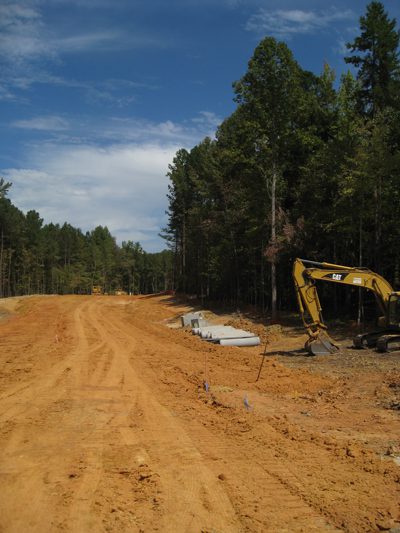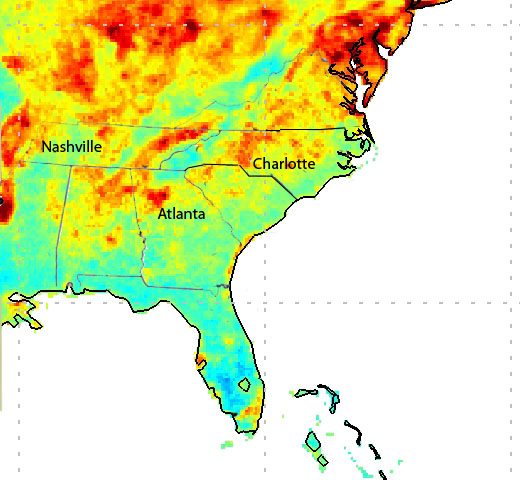Ozone pollution still troubles county

Air quality continues to be Mecklenburg County’s biggest environmental problem, says the county’s latest State of the Environment Report. Ozone pollution is the particular weak spot, the report says, rating that indicator “poor” – the only such rating in the report.
It took Mecklenburg County until the summers of 2008-10 to meet the 1997 national ozone standard. But Mecklenburg still has not met a stricter ozone standard imposed in 2008.
|
Read more about report This is the first of four State of the Environment report articles. Others examine land preservation, water quality and waste. |
The report, from Mecklenburg County’s Land Use and Environmental Services Agency, examines data and associated trends for four environmental indicators: air, land, water and waste. It also gives strategies for action to improve and protect the local environment.
The report is not available in print but can be found at the agency’s website. It uses Environmental Protection Agency standards, which are health-based and have been largely adopted by many states and localities. Levels of a pollutant that are higher than the standard pose a risk to human health.
While the report rates many of the county’s environmental indicators “good” and getting better, air quality remains a major concern. Poor air quality is a health hazard. It can worsen respiratory and cardiovascular disease, especially asthma, and affect visibility.
The report makes clear there remains much progress to be made in improving ozone pollution (rated “poor” but trending better) and particulate matter (rated “fair” and trending better). The other two air quality categories are “NOx, SO2, CO and Lead” (rated “good” and trending better) and “Overall Air Quality” (rated “good” and trending better).
Both ozone pollution and particulate matter are caused in part by gasoline- and diesel-powered vehicle emissions and off-road equipment. Many of the health effects associated with ozone pollution such as respiratory illnesses, decreased lung function, heart problems and asthma are also linked to particulate matter. Risks are greatest to children, the elderly and those working or exercising outdoors.
Report: Ozone is county’s worst environmental challenge
Ozone pollution received Mecklenburg’s only “poor” indicator, although the report rates it as trending better. Human activities are the primary source of ground-level ozone, and in Mecklenburg County the primary cause is driving.
|
What you can do Learn what individuals can do to help reduce air pollution: Click here |
Ozone is found in two parts of the Earth’s atmosphere – at ground level and in the upper regions. Both types of ozone have the same chemical composition (O₃). Although upper-atmospheric ozone protects the earth from the sun’s harmful rays, ground level ozone is the main component of smog.
Ground-level ozone forms when sunlight reacts with oxides of nitrogen (NOx) and volatile organic compounds (VOC). Ozone concentrations build during the afternoon and early evening and can reach harmful levels on hot, sunny days in urban areas. The major causes are mobile sources: cars, trucks and other nonroad equipment, which also contribute significantly to particulate matter pollution.
Nearly 700,000 vehicles are registered in Mecklenburg County, and the average number of miles driven (VMT or vehicle miles traveled) continues to rise at a steeper rate than vehicle registration. In other words, we are driving more and more each year. The 2011 census estimated the Mecklenburg County population at a little more than 944,000. That works out to 0.74 cars for every man, woman and child in the county – a telling statistic. The most effective way to reduce ground level ozone pollution, the report says, is to drive less.
Tiny particles: hard to see, but harmful
Air pollution caused by fine particles is rated only “fair” but improving.
Particulate matter, the county report says, is “a complex mixture of extremely small particles and liquid droplets. Particle pollution is made up of a number of components, including acids (such as nitrates and sulfates), organic chemicals, metals, and soil or dust particles.”
The EPA has two categories for particle pollution. “Inhalable coarse particles,” such as those found near roads and dusty industries, are larger than 2.5 micrometers and smaller than 10 micrometers in diameter. “Fine particles,” such as those found in smoke and haze, are 2.5 micrometers in diameter and smaller (less than 1/30th the diameter of a human hair). Current standards have been in place since 1997. However, the EPA is required by the Clean Air Act to review standards every five years, and as a result, in June 2012 it proposed stricter standards for fine particle pollution and to set a separate standard to improve visibility, primarily in urban areas. “The new evidence includes more than 300 new epidemiological studies, many of which report adverse health effects even in areas that meet the current PM2.5 standards,” the EPA states. The standard for coarse particles will remain the same. Final standards will be issued by December 14, 2012.
Particle pollution can be directly emitted from fires or can form when gases from power plants, industries and automobiles react in the air.
 When inhaled, the fine particles can lodge deep, seriously affecting the heart and lungs. Some may even get into the bloodstream. Fine particles also cause haze in urban areas and reduce visibility in national parks and wilderness areas. The EPA says these particles “can remain suspended in the air and travel long distances. For example, a puff of exhaust from a diesel truck in Los Angeles can end up over the Grand Canyon.”
When inhaled, the fine particles can lodge deep, seriously affecting the heart and lungs. Some may even get into the bloodstream. Fine particles also cause haze in urban areas and reduce visibility in national parks and wilderness areas. The EPA says these particles “can remain suspended in the air and travel long distances. For example, a puff of exhaust from a diesel truck in Los Angeles can end up over the Grand Canyon.”
Particulate matter also settles back down and pollutes soil, crops, and water. “The effects of this settling include: making lakes and streams acidic; changing the nutrient balance in coastal waters and large river basins; depleting the nutrients in soil; damaging sensitive forests and farm crops; and affecting the diversity of ecosystems,” the EPA says.
Other particle matter pollution may come directly from an identifiable source, such as a construction site or smokestack. Mecklenburg County has a number of permitted, dusty industries such as concrete manufacturing (15 sites), asphalt paving and block manufacturing (10 sites) and stone mining and quarrying (6 sites). Additionally, numerous construction sites fill the air with dirt and dust on a daily basis, and large construction projects can take years to complete, lengthening exposure time.
Ozone, fine particles aren’t all
Within the air quality category, “area source” pollution is a tricky curve to maneuver. According to the report, “An area source is a collection of individually small emission sources within a single geographical area that produces similar air pollutants. Area sources are classified together by air quality control agencies to facilitate estimating emissions from their activities because they are usually too small or too numerous to be inventoried individually.”
Even though permits are required for larger area sources, such as gas stations or automobile refinishing shops, most area sources are exempt from the permitting process due to “size, activity, or emission rate.”
For ways that you can make a difference in Mecklenburg’s air quality, see the companion article linked in the sidebar above.
The NASA satellite-based image below shows the particle matter pollution concentrations in the southeast.
